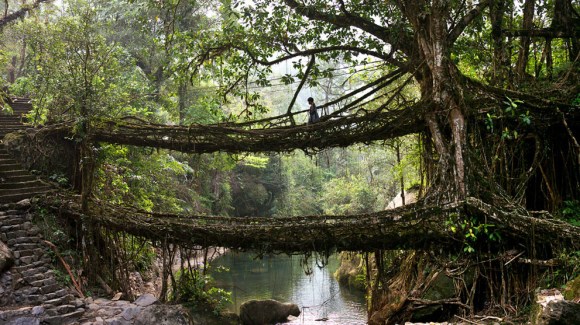
Now that we’re well into the sweltering, cicada-droning final days of summer in Japan, can you even remember what it felt like during the rainy season earlier this summer? If you complained nonstop about having to leave the house day after day with an umbrella in tow at the time, you may actually be thankful for those comparatively ‘dry’ rainy days after seeing these pictures from the rainiest place on Earth.
While the location of the highest average annual rainfall in the world can be debated based on the source and conflicting data sets, for the purposes of this article we’ll be saying that the honor of that title goes to a pair of villages in northeastern India. In case you’re curious, the two towns of Lloró and Lopez del Micay in Colombia and Mount Waialeale in Hawaii, USA, have also made recent claims to the title.
The two villages are located north of Bangladesh in the northeastern Indian state of Meghalaya (which means “the abode of clouds” in Sanskrit). The village of Mawsynram receives an annual rainfall of 11,872 mm/467.4 inches (that’s 13 times the amount in Seattle!), and is currently considered to be the rainiest place on Earth. 16 km (9.9 mi) to the west of Mawsynran is the second village of Cherrapunji, also known as Sohra. Cherrapunji remains the world record holder for highest rainfall in a single month (9,300 mm/366 inches in July 1861) and in a calendar year (26,461 mm/1,041.75 inches between August 1960 and July 1961).
Both of the villages are part of the Khasi Hills area of Meghalaya, which is a subtropical highland climate home to roughly 1.25 million indigenous Khasi people, a matrilineal culture.
▼Location of the state of Meghalaya in India
Almost all of the rainfall in the area occurs during the monsoon months, when winds blowing from the Bay of Bengal concentrate the rains over the Khasi Hills and valley area. But try to wrap your mind around this–despite being possibly the wettest place on Earth, drought is actually a significant problem in Meghalaya during the non-monsoon months due to rampant deforestation and heavy rains washing away topsoil. Scientists would be wise to increase conservation efforts because the surrounding forests boast some of the greatest biodiverity in all of Asia, including almost 325 varieties of orchids and nine critically endangered species of birds.
We were initially attracted to Meghalaya after stumbling across some stunning photographs taken by New Zealand journalist and photographer Amos Chapple in this article run by The Atlantic. Maybe someday we can send one of our own reporters there to check out the living tree bridges, but until then we’ll make do with the following exquisite pictures, which still don’t manage to do the area justice.
▼Mawsynram
▼A new digital measurement system will be implemented by the end of this year at this weather station.
▼Villagers wear these bamboo and banana leaf full-body umbrellas, called knups, as they go about their daily work.
▼26-year-old Winchester Lyngkhoi carries fresh meat up to his stall on market day. When asked if it’s hard to live in such a rainy place, he replied, “We can’t think about that. Here there’s always rain but we have to work, so it’s no good wondering.”
▼Approximately 70 percent of the Khasi people are Christian, as a result of a Welsh missionary in the mid-1840s.
▼Goats at a bus stop
Particularly famous in the region are the previously-mentioned living tree bridges, which last for hundreds of years whereas regular wooden structures would soon rot in the damp environment. Villagers guide the roots of rubber trees to grow in a specific pattern so that they develop into sturdy structures capable of being walked across.
▼Close-ups showing how the locals manipulate tree roots into growing into bridges.
▼An example of a living bridge being ‘grown’ using a support of bamboo.
▼Living ladders also exist
It’s absolutely stunning. There are no words to describe the natural beauty of this place.
Sources: The Atlantic, Unusual Places, Wikipedia, Weather
Images: Amos Chapple (Facebook), Wikipedia (Planemad)